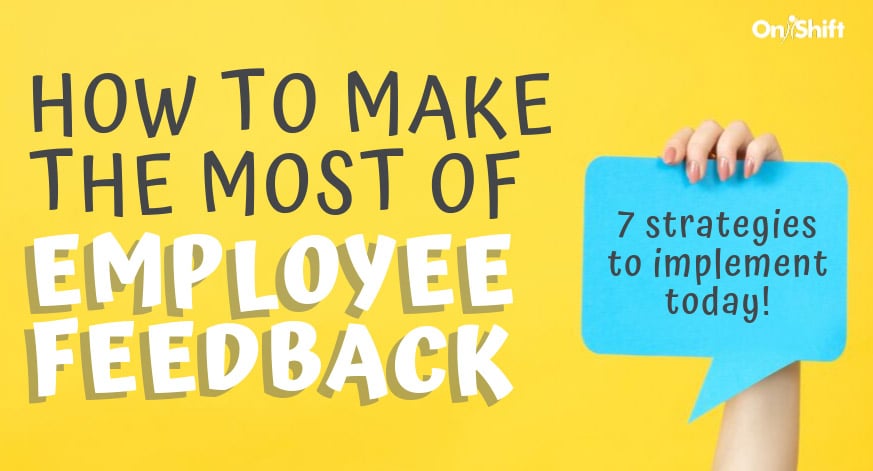October 9, 2019 | Jenna Berris
October 9, 2019 | Jenna Berris
 These days, the long-term care provider that does not gather employee feedback finds it harder to sustain success. In fact, all employers are being tasked with increasing their feedback process in order to engage a younger generation of workers.
These days, the long-term care provider that does not gather employee feedback finds it harder to sustain success. In fact, all employers are being tasked with increasing their feedback process in order to engage a younger generation of workers.
Gathering — and responding to — employee feedback is proven to reduce staff turnover, improve worker productivity and efficiency, and foster happier workplace environments.
Today, 34% of U.S. workers are engaged in their workplaces, according to an August 2018 Gallup poll. These workers are more involved in their jobs, are passionate about their roles and feel like an essential part of their organization’s success.
They are also less likely to leave. Providers that improved employee retention by 10% would see an equal reduction in risk expense, as well as a 2% increase in occupancy, according to a whitepaper from industry association Argentum and consultancy Great Place to Work.
Here are 7 feedback strategies to implement at your community to keep employees engaged and on the path to success.
Annual surveys alone aren’t enough when it comes to collecting feedback. They’re too infrequent and by the time they roll around, many employees that had issues over the last twelve months are disengaged beyond repair or have turned over.
Pulse surveys can be used to collect regular feedback from employees to uncover and remedy smaller issues before they become larger ones and make organizational improvements. The pulse surveys in OnShift Engage are quick and easy for management to administer and for employees to complete. They even contain an optional comment box for any additional feedback and respondents can identify themselves or choose to remain anonymous.
In talking with caregivers, we've learned things like supplies aren't being stocked properly and they feel the work they do is never appreciated. By collecting employee feedback, providers have been able to address these situations and make process improvements. Plus, simply asking for input from staff shows your organization values their opinions and ideas and gives them a voice to promote positive change.
One of the most important elements of any feedback strategy is reaching out to employees that provide it. Let them know you received their comment or suggestion and are working on a solution. If you are unable to develop a solution or make any changes at the time, let them know why. Employees will become more likely to to provide feedback if management takes their input seriously and makes a noticeable effort to help.
If the feedback is negative, ask an employee to elaborate on why he or she feels that way about a specific aspect of the job. Get them to share why they feel the way they do. This turns a negative into a positive and fosters a solid working relationship between employee and supervisor.
As with any serious conversation, do not be afraid to broach difficult topics. A workforce will be more willing to open up if they know they can broach any issue with management, no matter how difficult it can be.
Polling workers on their daily tasks is a good entry to developing employee engagement and feedback. What do they like about their daily routine? Where is there room for improvement? Are workplace goals clearly defined, and how are employees held accountable for meeting those goals?
Measuring employee feedback on daily tasks can quickly establish baselines for communication, separate the motivated workers from those simply going through the motions, lay the foundation for better training programs and let management know which employees to groom for development and upward career paths.
Make sure that employees know they can offer their feedback at any time, whether or not it is solicited by management. An open-door policy allows management to gauge which employees are engaged, and to what extent. It also shows the extent to which employees are invested in the company’s success and shows them that management is there to offer them support when they need it.
Great coaching can improve the frequency and quality of employee feedback. Coaching puts employees in a better position to succeed and builds on the teamwork and conversations being fostered between team members and management.
Ask your employees about their career goals, where they see themselves in ten years, what new skills they’d like to learn and where they think they can improve. Management should offer their two cents and guidance during these conversations and start to outline goals and timelines.
A tried and true method for collecting feedback (albeit often not so positive feedback), the exit interview provides valuable insight into areas that need improvement. Find out the reasons for an employee’s departure and evaluate if you need to update certain processes or policies in your community based on their feedback.
Conversely, use the stay interview to find out what keeps employees from leaving your community. This is a great way to get some face-to-face time with employees, learn what is working and get recommendations from employees that are engaged and satisfied in their roles.
As you collect feedback and work to implement changes around your community, make sure to keep everyone in the feedback loop updated. Tell your employees about some of the feedback you’ve been receiving and how you plan to or are responding. Remember, the best way to keep employees engaged and delivering feedback is to show you are taking it seriously and doing all that you can to address it and improve workplace culture.
Subscribe to the OnShift Blog
Recent Posts
Categories
About Jenna Berris
Jenna Berris is a Content Marketing Manager for OnShift.
See for yourself why thousands of providers rely on OnShift’s innovative software for recruitment, hiring, workforce management, pay and engagement. Request your personalized demo today.
